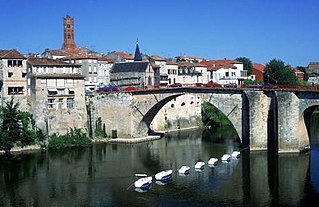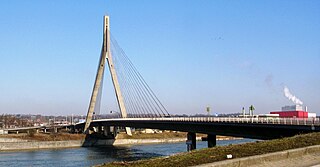
François-René, vicomte de Chateaubriand was a French writer, politician, diplomat and historian who had a notable influence on French literature of the nineteenth century. Descended from an old aristocratic family from Brittany, Chateaubriand was a royalist by political disposition. In an age when large numbers of intellectuals turned against the Church, he authored the Génie du christianisme in defense of the Catholic faith. His works include the autobiography Mémoires d'Outre-Tombe, published posthumously in 1849–1850.

The Pont du Gard is an ancient Roman aqueduct bridge built in the first century AD to carry water over 50 km (31 mi) to the Roman colony of Nemausus (Nîmes). It crosses the river Gardon near the town of Vers-Pont-du-Gard in southern France. The Pont du Gard is the tallest of all Roman aqueduct bridges, as well as one of the best preserved. It was added to UNESCO's list of World Heritage sites in 1985 because of its exceptional preservation, historical importance, and architectural ingenuity.

Eugène Freyssinet was a French structural and civil engineer. He was the major pioneer of prestressed concrete.

The Pont Saint-Bénézet, also known as the Pont d'Avignon, was a medieval bridge across the Rhône in the town of Avignon, in southern France. Only four arches survive.

The Millau Viaduct is a multispan cable-stayed bridge completed in 2004 across the gorge valley of the Tarn near Millau in the Aveyron department in the Occitanie Region, in Southern France. The design team was led by engineer Michel Virlogeux and English architect Norman Foster. As of October 2023, it is the tallest bridge in the world, having a structural height of 336.4 metres (1,104 ft).

Villeneuve-sur-Lot is a town and commune in the southwestern French department of Lot-et-Garonne. The commune was formerly named Villeneuve-d'Agen.

Albert Irénée Caquot was considered the "best living French engineer" for half of a century. He received the “Croix de Guerre 1914–1918 (France)” and was Grand-croix of the Légion d’Honneur (1951). In 1962, he was awarded the Wilhelm Exner Medal. He was a member of the French Academy of Sciences from 1934 until his death in 1976.

The Hampden County Memorial Bridge is a reinforced-concrete arch bridge that spans the Connecticut River between Springfield, Massachusetts and West Springfield, Massachusetts, constructed in 1922. The bridge is owned by Massachusetts Highway Department and is located on Massachusetts Route 147. It spans 209 feet (64 m) and rises 29.71 feet (9.06 m) above the river.

Le Minihic-sur-Rance is a commune in the Ille-et-Vilaine department in Brittany in northwestern France.

The Pont de Bonpas is a bridge over the Durance river, connecting the south of Vaucluse to the north of Bouches-du-Rhône in southern France. An initial stone bridge was constructed between 1189 and 1199 and destroyed by a 1272 flood. Reconstruction was attempted in 1316 but ultimately failed. A new bridge was not completed until 1812. This was later damaged by flood and a suspension bridge opened in 1894, but was destroyed in 1944. The current bridge was constructed in 1954 and is 500 metres (1,600 ft) long with twelve arches.

The Pont de Wandre is a single-pier cable-stayed bridge carrying the N667 road across the Albert Canal and the river Meuse between Liège and Herstal, both in Belgium.

Paul Séjourné was a French engineer who specialized in the construction of large bridges from masonry, a domain in which he made some important innovations.
Émiland Marie Gauthey was a French mathematician, civil engineer and architect. As an engineer for the Estates of Burgundy, he was the creator of a great deal of the region's civil infrastructure, such as the Canal du Centre between Digoin and Chalon-sur-Saône (1784–1793), bridges including those at Navilly (1782–1790) and Gueugnon (1784–1787), and buildings such as the Eglise Saint-Pierre-et-Saint-Paul at Givry and the theatre at Chalon-sur-Saône.
The Prix Combourg-Chateaubriand is a French literary award created in 1998 by Hervé Louboutin and Sonia de La Tour du Pin. It is awarded by the Académie Chateaubriand, under the presidency of Philippe de Saint Robert since 1999, in memory of the writer François-René de Chateaubriand. The award ceremony takes place at the Château de Combourg in Ille-et-Vilaine, where Chateaubriand lived during a part of his youth.

The Grandfey-Viaduct is on the railway line from Bern to Fribourg and is one of the largest bridges in Switzerland.

Pont de l'Artuby, also called Pont sur l'Artuby or Pont de Chaulière, is a two-lane road bridge that connects Route D 71 to the Artuby Gorge in the Var department in the French region of Provence-Alpes-Côte d'Azur. The nearest towns are Aiguines and Trigance, which are 22 and 13 km away respectively.
















